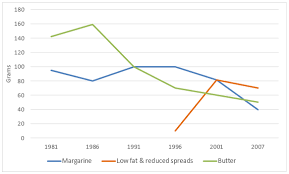You should spend about 20 minutes on this task.
The graph below shows the daily consumption of three spreads per person from 1981 to 2007 in a country. Summarise the information by selecting and reporting the main features, and make comparisons where relevant.
You should write at least 150 words.

Sample Answer 1
The consumption of margarine, butter and low-fat spreads in a country from 1981 to 2007 is compared in the line chart. The daily per person ingesting is measured in grams. It is apparent that low fat & reduced spread had been in use from 1996 but soon it became the most preferred spread type in this country.
As the data suggests, butter was the most consumed spread type in 1981 with slightly over 140-gram daily intakes. Consumption of margarine in this year was just below 100 grams. After 5 years, the use of butter rose while it actually decreased for margarine. But both of their daily consumption intersected in 1991 as the demand for margarine remained steady till 1996 at which point butter consumption dripped as low as 65 grams per person. The use of butter steadily declined after 1986. The ‘low fat and reduced spread’ was introduced in 1996 and it soon became the most consumed spread type with a sharp rise in its use. In 2001, the demand for the latter spread reached as high as 80 grams while the other two spreads were losing their demand. Finally, in 2007, people consumed around 70 grams low fat and reduced spread, and consumptions of butter and margarine were around 45 and 40 grams consecutively at that time.
Sample Answer 2
The line graph compares per day consumption of three different spreads – ‘margarine’, ‘low fat & reduced spreads’, and ‘butter’ in a country between 1981 and 2007. Daily per person consumption has been measured in grams.
Overall, the consumption of all spreads declined significantly from 1981 to 2007 with the exception of low fat & reduced spreads.
Looking into detail, butter was the most preferred spread with 141 grams per day per person consumption in 1981. Consumption of margarine and low fat & reduced spreads was 99 grams and just 10 grams, respectively, in the same year. While the consumption of butter and dropped remarkably afterwards, people started to consume less amount of margarine as well. However, the intake of low fat and reduced spreads increased drastically and reached the peak of 80 grams in 2001, and became the most consumed spread in 2007.
The consumption of butter and margarine decreased dramatically over a period of 28 years. In details, butter’s consumption rose steadily and touched a high of 170 grams per capita in 1986, but after that, it decreased continuously and reached nearly 55 grams by 2007. Similarly, margarine showed the same trend with some fluctuations, decreasing from 100 grams to 80 grams between 1979 and 2007.
[Written by – Vicky]
